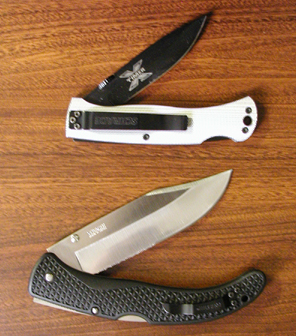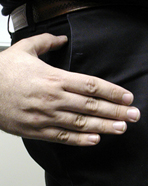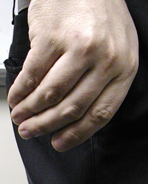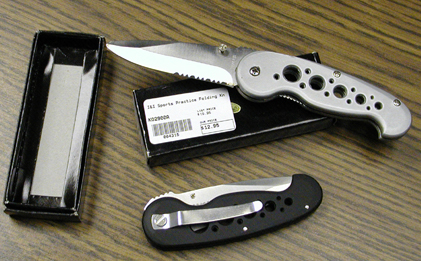its paid sponsors, whose products you need!
“Stay ‘unreasonable.’ If you don’t like the solutions
[available to you], come up with your own.”
Dan Webre
The Martialist does not constitute legal advice.
It is for ENTERTAINMENT PURPOSES ONLY.
Copyright © 2003-2004 Phil Elmore, all rights reserved.
Drawing Tip-Up and Tip-Down Folders
By Phil Elmore
DISCLAIMER: USING A KNIFE IS INHERENTLY DANGEROUS.
The Martialist disclaims all
liability for accidents that occur while working with knives. Train
safely with appropriate equipment, including dull training knives where
applicable.
One of the features that defines the
tactical
folding knife is the pocket clip. Similar to the clip on a pager, the
pocket clip on a folding knife makes it easy to attach the knife inside a pocket
or waistband (or to virtually anything thin enough to accommodate the
clip). One of the eternal debates within the knife enthusiast community is
summed up by the question, “Tip-up or tip-down?”
As seen in the picture below, the pocket clip can be oriented
one of two ways (and can be removed and mounted again in either position on some
knives). When the knife is clipped inside a pocket and the tip of the
closed blade points up, it is a tip-up knife. When the knife is
clipped inside a pocket and the tip of the closed blade points down, it is a tip-down
knife.

The knife on top is “tip-down,” while the
knife on the bottom is “tip-up.”
Fans of tip-up folders often prefer them because they believe
these knives are quicker and easier to draw and deploy. Those who do not
prefer tip-up carry will counter that they’ve stabbed themselves in the
fingertips drawing tip-up knives that opened slightly in their pockets. I
won’t lie to you — I have received such an injury and prefer tip-down carry for
that reason. Still, the question of draw need not be the deciding
factor. Drawing tip-up and tip-down knives with speed and efficiency is
really just a matter of how you position your hand for the draw. A tip-up
knife allows for a somewhat more natural draw, but a tip-down draw is not much
more difficult.
 When drawing the tip-down folder, you must position your hand to draw the knife up and out with your thumb pointing forward. |
 When drawing the tip-up folder you can use a more natural hand position. The thumb points to the rear as you draw the knife up and out. |
To practice drawing tip-down and tip-up folders, you must first
obtain a relatively safe practice tool. A regular folding knife that has
been ground dull is fine. There are a number of model-specific
“drones” on the market, too, as well as no-name generic training
folders.

Inexpensive “generic” training folders are useful for safe practice.
Use such tools the first time you learn skills of the type described here.
These knives even appear to be serrated, but their
edges
have not
been honed. (They’re still far too sharp for safe sparring, however.)
|
Drawing The Tip-Down Folder With the knife Step 1: Reach for your knife. As your Step 2: Step 3: Step 4: Thumb |
|
Drawing The Tip-Up Folder With the knife
Step 1: Reach for your knife. As your Step 2: Step 3: Draw the knife. Step 4: Thumb
|
As with so much where weapons and tools are concerned, the
choice of tip-up or tip-down is more a matter of personal preference than
anything else. With practice you can learn to deploy your knife in a
single fluid motion, quickly and efficiently.
Train safely.
